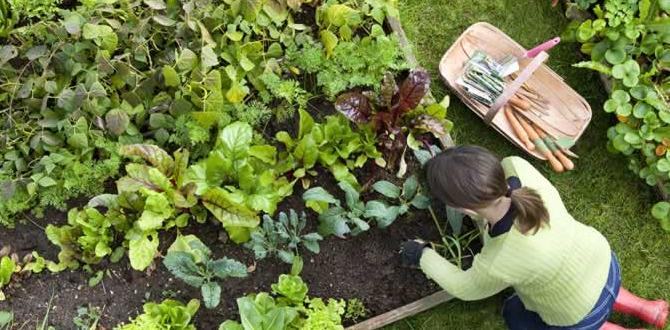Indoor humidity is crucial for plant health and comfort. Maintaining the right level, typically between 40-60%, prevents dry air issues for plants and people, ensuring a thriving indoor environment. This guide simplifies how to measure and adjust humidity for your home and plants.
Hey green thumbs! Ever notice your indoor plants looking a little sad, leaves crispy, or just not growing as much as you’d hoped? Or maybe your own skin feels dry, and you’re getting more static shocks than usual? There’s a good chance the culprit is invisible: the humidity levels in your home. For those of us nurturing leafy friends indoors, or just aiming for a cozier living space, understanding and managing indoor humidity is key. It might sound technical, but I promise we’ll break it down super simply. Let’s dive in and make your indoor world a little happier and healthier, one moisture molecule at a time!
Why Humidity Matters for Your Indoor Oasis
Humidity is simply the amount of water vapor in the air. Think of it as the air’s hidden moisture content. For our beloved houseplants, this is super important because many come from lush, tropical environments where the air is naturally moist. When the air in our homes is too dry, plants can’t get enough moisture through their leaves, and this can lead to a whole host of problems. It’s like us trying to live in a desert – it’s just not ideal for long-term health and happiness. So, giving them the right humidity is one of the easiest ways to help them thrive and look their absolute best.
But it’s not just about the plants! Proper humidity levels in your home can also make a big difference for you and your family. Dry air can lead to dry skin, chapped lips, irritated sinuses, and even make you more susceptible to colds and the flu. For your home itself, dry air can cause wooden furniture to crack, wallpaper to peel, and electronics to be more prone to static, which can damage sensitive components. Creating a balanced humidity environment is a win-win for everyone and everything under your roof.
What’s the Ideal Humidity Range?
When we talk about ideal humidity, we’re generally looking for a sweet spot. For most homes and a wide variety of indoor plants, the recommended humidity range is between 40% and 60%. This range is often considered comfortable for humans and healthy for a majority of common houseplants. However, this isn’t a strict, one-size-fits-all rule. Some plants, like those native to desert regions, might prefer slightly lower humidity, while others from super tropical areas might be happiest closer to that 60% mark, or even a touch higher.
It’s worth noting that some heating and cooling systems can drastically alter your home’s humidity. Winter heating, in particular, tends to dry out the air significantly, pushing humidity levels way down. Conversely, summer air conditioning can sometimes make indoor air feel damp if it’s not set correctly or if there are other moisture issues. So, being aware of the seasons and your HVAC system’s impact is part of the puzzle.
Measuring Your Indoor Humidity: The First Step to Control
Before you can adjust anything, you need to know where you stand! Thankfully, measuring humidity is incredibly easy and doesn’t require a science degree. The most common and accessible tool is a hygrometer.
What is a Hygrometer?
A hygrometer is a small device that measures the amount of water vapor in the air. Think of it like a thermometer for humidity. They come in various forms, from simple analog versions to sophisticated digital ones.
- Digital Hygrometers: These are the most popular choice for home use. They usually have a clear digital display showing the current humidity percentage (%) and often the temperature as well. They are generally accurate, easy to read, and affordable. Many even have a memory function to show high/low readings.
- Analog Hygrometers: These are the older-style gauges with a needle pointing to a humidity scale. While they can be charming, they are often less accurate than digital models and can require calibration.
- Smart Home Devices: Some smart thermostats or standalone smart home sensors include humidity monitoring as part of their features. These can often be integrated with apps to track changes over time.
How to Use a Hygrometer
Using a hygrometer is as simple as this:
- Placement: Find a good spot in the room you want to monitor. Avoid placing it directly next to a humidifier, dehumidifier, open window, or heating/cooling vent, as this can give you an inaccurate reading of the general room humidity. A spot on an interior wall, away from direct sunlight and drafts, is usually best.
- Read the Display: Turn on your digital hygrometer (if it has a power button) and wait a few minutes for it to acclimate to the room’s environment. The display will then show the current humidity level as a percentage.
- Monitor Over Time: Don’t just check it once! Humidity levels can fluctuate throughout the day and with changes in weather or your home’s systems. Check it at different times to get a better understanding of your typical range.
For a more comprehensive understanding of humidity in different parts of your house, you might even consider getting a few hygrometers to place in different rooms or zones. This can highlight areas that might need specific attention.
Common Signs of Incorrect Humidity Levels
Your plants and your home will often give you clues that the humidity isn’t quite right. Learning to spot these signs can help you address issues before they become major problems.
Signs of Low Humidity (Too Dry)
If your air is too dry, you might notice:
- For Plants:
- Brown, crispy leaf tips or edges.
- Leaves that curl or droop more than usual.
- Slowed growth or stunted plant development.
- Increased susceptibility to pests like spider mites, which love dry conditions.
- Flowers dropping before they have a chance to fully bloom.
- For You & Your Home:
- Dry, itchy skin and lips.
- Sore throat or dry, scratchy feeling in your throat.
- Increased static electricity (think zaps when you touch things!).
- Wooden furniture or floors that develop cracks.
- Worrying about dust and dander circulating more easily.
Signs of High Humidity (Too Humid)
While less common in many homes, especially during winter, too much humidity can also cause problems:
- For Plants:
- Fungal diseases like powdery mildew, which thrive in damp conditions.
- Root rot if the soil stays too wet for too long due to poor air circulation.
- Yellowing leaves that might feel mushy.
- For You & Your Home:
- A musty smell in the air.
- Condensation on windows or walls.
- Peeling paint or wallpaper.
- Mold and mildew growth, which can be a health hazard.
- A generally clammy, uncomfortable feeling indoors.
How to Increase Indoor Humidity
Got a hygrometer reading that’s too low? Don’t fret! There are plenty of easy and effective ways to boost the moisture in your air, ranging from simple DIY tricks to dedicated gadgets.
1. The Humble Humidifier
This is the most direct and often most effective way to add moisture to your air. Humidifiers come in various types:
- Cool Mist Humidifiers: These use a fan to blow air through a wick or filter soaked in water, dispersing a cool mist. They are generally safer for homes with children or pets as there’s no hot water involved.
- Warm Mist Humidifiers: These boil water to create steam, which is then released as a warm mist. This process can help kill bacteria and minerals in the water, but they use more energy and require more caution due to the hot steam.
- Ultrasonic Humidifiers: Similar to cool mist, these use ultrasonic vibrations to create a fine mist. They are usually very quiet.
- Evaporative Humidifiers: These use a fan to blow air through a wet wick or filter, causing the water to evaporate into the air. They are self-regulating to some extent, as the drier the air, the faster the evaporation.
Tip: When using a humidifier, it’s important to clean it regularly according to the manufacturer’s instructions. Dirty humidifiers can breed mold and bacteria, which then get dispersed into your air. Using distilled or demineralized water can also help reduce mineral buildup and white dust.
2. Group Your Plants Together
Plants release moisture from their leaves through a process called transpiration. When you cluster your plants together, they create a microclimate with slightly higher humidity around them. It’s like a mini tropical rainforest in your living room!
How to do it: Simply arrange your plants closer to each other. You can even place them on trays filled with pebbles and water. The water will evaporate from the tray, naturally increasing humidity around the plants without them sitting directly in water (which can cause root rot).
3. Pebble Trays Add Moisture
This is a classic and simple gardening hack. You’ll need a tray (a plant saucer works well), some pebbles or gravel, and water.
- Fill the tray with a layer of pebbles or gravel – enough to cover the bottom.
- Add water to the tray until it’s about halfway up the pebbles, but make sure the water level stays below the top of the pebbles.
- Place your potted plant on top of the pebbles.
As the water evaporates from the tray, it increases the humidity around your plant. Make sure to refill the water regularly.
4. Misting (Use with Caution!)
A quick spritz of water from a spray bottle can give your plants a temporary humidity boost and also clean dust off their leaves. However, misting only provides a very short-lived increase in humidity, and is often not enough on its own for plants that need consistently high humidity.
Important Note: Misting can also encourage fungal diseases if leaves stay wet for too long, especially in poorly ventilated areas. It’s best to mist in the morning so leaves have time to dry throughout the day, and ensure good air circulation. Some plants, especially those with fuzzy leaves (like African violets), don’t appreciate misting at all.
5. Water Features and Aquariums
Larger water features, like a small tabletop fountain, or even just an open aquarium, can contribute to raising the overall humidity in a room as water evaporates from their surfaces. This is a beautiful and natural way to add moisture to the air while also providing a serene ambiance.
6. Dry Your Laundry Indoors
If you have a clothes drying rack, consider drying some of your laundry indoors. As the clothes dry, they release moisture into the air, which can significantly increase humidity levels. Just be mindful of not overdoing this, as it can lead to excessively damp air if ventilation is poor.
7. Cook and Shower with Doors Open
Simple everyday activities can help! When you’re cooking on the stovetop (especially boiling or simmering) or taking a hot shower, steam is released. If you leave the kitchen or bathroom door open afterward (or during, if appropriate), this moisture can drift into other parts of your home and lend a hand in raising humidity levels.
For more in-depth information on managing humidity naturally, you might find resources from university extension offices helpful, such as those from University of Illinois Extension, which often provide practical household tips.
How to Decrease Indoor Humidity
If your hygrometer is showing readings consistently above 60%, it’s time to bring the moisture level down. This is often more of an issue in humid climates, during summer months, or in poorly ventilated areas like basements.
1. Use a Dehumidifier
This is the most effective tool for reducing excess humidity. Dehumidifiers work by pulling moist air in, cooling it to condense the water, and then releasing drier air back into the room. You can set them to a specific humidity level, and they often have a collection tank that needs emptying, or a hose attachment for continuous drainage.
2. Improve Ventilation
Good airflow is crucial for managing both low and high humidity. Open windows and doors when weather permits to allow fresh air to circulate. Use exhaust fans in bathrooms and kitchens to remove moist air directly at the source. Ensure furniture isn’t pushed too tightly against walls, allowing air to circulate behind it.
3. Use Fans
Ceiling fans and portable fans help move air around the room. This prevents stagnant pockets of moist air from forming and encourages more even humidity distribution. In humid environments, fans can make you feel cooler by increasing evaporation from your skin.
4. Check for Leaks and Water Damage
Persistent high humidity can sometimes be a sign of underlying issues like plumbing leaks, roof leaks, or inadequate insulation that causes condensation. Address these problems promptly to prevent mold growth and further damage.
5. Avoid Indoor Drying Racks (if excessively humid)
While drying laundry indoors can help increase humidity, if your house is already too humid, it can exacerbate the problem. Consider using a clothes dryer or drying laundry in a well-ventilated or outdoor space instead.
6. Consider Air Conditioning
Air conditioners not only cool the air but also dehumidify it as a byproduct of the cooling process. Running your AC can help lower indoor humidity, especially during hot, muggy weather.
Humidity Needs of Popular Indoor Plants
Different plants hail from different climates, and thus have varying humidity preferences. Here’s a look at some popular choices and what they generally prefer:
| Plant Name | Ideal Humidity Range | Notes |
|---|---|---|
| Peace Lily (Spathiphyllum) | 40-60% (Prefers 50%+) | Loves moist air. Crispy leaves are a sure sign of dry air. Misting, pebble trays, or grouping are helpful. |
| Ferns (e.g., Boston Fern, Maidenhair Fern) | 50-70% (Prefers 60%+) | These are humidity addicts! They will struggle in dry air. Closely group, use humidifiers, or place in humid rooms like bathrooms. |
| Orchids (e.g., Phalaenopsis) | 40-70% (Prefers 50-70%) | Most orchids thrive in higher humidity environments, mimicking their native tropical habitats. Good air circulation is also vital. |
| Fiddle Leaf Fig (Ficus lyrata) | 40-60% | While they can tolerate average home humidity, they appreciate consistent moisture and will be happier with good levels. Avoid drafts and dry air. |
| Monstera Deliciosa | 40-60% | Adaptable, but loves to feel like it’s in a humid jungle. Dry air can lead to smaller leaves or less fenestration (leaf splits). |
| Snake Plant (Sansevieria) | 30-50% | Very tolerant of dry air. They prefer lower humidity and can be susceptible to root rot in overly moist conditions. |
| ZZ Plant (Zamioculcas zamiifolia) | 30-50% | Another drought and dry-air tolerant plant. It stores water in its rhizomes, making it very resilient. |
| Pothos (Epipremnum aureum) | 40-60% | Quite forgiving and adaptable to various humidity levels, but will grow best with moderate to high humidity. |
| Calathea / Prayer Plants | 50-80% (Prefers 60%+) | These are notoriously fussy about low humidity and will show brown, crispy edges on their leaves. Grouping, humidifiers, and frequent misting (if well-ventilated) are key. |
Notice a pattern? Plants often described as “tropical” or those with thinner leaves generally crave higher humidity. Plants that are naturally drought-tolerant or have thicker, succulent-like leaves are usually more forgiving of dry air. When in doubt, a quick online search for your specific plant’s native habitat can give you clues about its humidity needs.
What About Humidifier Efficiency?
When you’re thinking about adding a humidifier, it’s helpful to understand what makes one more or less effective. Factors





